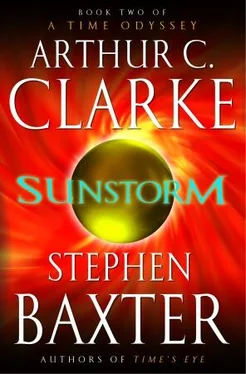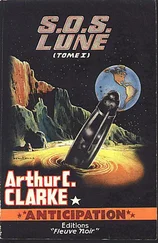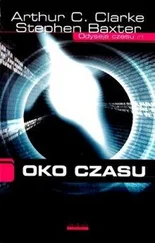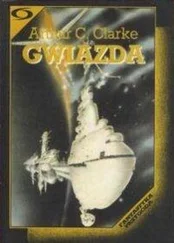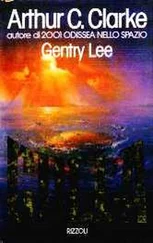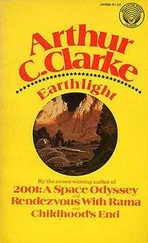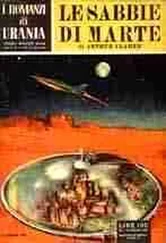Bud, acting as chair, stood beside her. “Before we start, let me just say one thing,” he began. “Astronauts have a proud history in solar studies. It goes back to the Skylab guys who, in Earth orbit in 1973, operated an imaging spectrograph built for them by Harvard. Today we’re continuing that tradition. But we’re not just talking about science. Today we’re being asked for our help. As the commander of Clavius Base I consider it an honor to have Professor McGorran here—an honor that we on the Moon are seen as fit to be the focus of the response to this problem. Professor.” He nodded to Siobhan and sat down.
After that pep talk, not entirely appropriate, Siobhan glanced around the table. She caught just one friendly eye, a sympathetic half smile from Mikhail Martynov. Follow that.
“Good morning. I expect to do more listening than talking today, but I’d like to make some introductory remarks. My name is—”
“We know who you are.” The speaker was evidently one of the geologists, a stocky, big-armed woman with a square face. Her glare was about the most hostile in the room.
“Then you have me at a disadvantage, Doctor—”
“Professor. Professor Rose Delea.” She had a broad Australian accent. Siobhan had been briefed; Rose was an expert on the emplacement by sunlight of helium-3 in the lunar regolith. This helium isotope, a fuel for fusion reactors, was the Moon’s best economic prospect, and so Rose was a weighty figure here. “All I want to know is when you’re going to leave so I can get back to some real work. And I want to know the reason for all this secrecy. Since June 9 outgoing comms has been restricted, some areas of Thales’s databases and other information stores have been proscribed—”
“I know.”
“This is the Moon, Professor McGorran. If you hadn’t noticed, we’re all a long way from home and our families. Links to Earth are essential for our psychological well-being, not to mention our physical safety. And if you don’t want morale to fall farther—”
Siobhan held up her hand, a gesture of quiet command. To her relief, Rose fell silent. “I quite agree.” So she did. Secrecy didn’t come instinctively to her any more than to these Moon-folk, Siobhan suspected; openness was an essential component of the endless conversation that underpinned good science. She said, “The security blackout is difficult for all concerned, and would be unacceptable—in normal times. But these are not normal times. Please bear with me.
“I’m standing before you today as an emissary of both the British Prime Minister and the Prime Minister of the Eurasian Union. When I get home I’ll also be expected to brief other world leaders, including President Alvarez of the United States. And what they want to know is what to expect of the sun.”
She was met by mostly baffled stares. Her briefings by various world-weary politicians’ aides had warned her to expect a certain insularity up here on the Moon, where the Earth could seem a long way away, and not very important. So she had prepared a show-and-tell. “Thales, please …”
She gave them a five minute summary, in images, graphics, and words, of the devastating impact of June 9 on the Earth. This was watched in somber silence.
At the end she said, “And that’s the reason I’m here, Professor Delea. I need some answers—we all do. What’s wrong with the sun? Is June 9 going to hit us again? Can we expect something less—or worse? On the Moon—in this room, in fact—you have some of humankind’s top solar scientists. And the one person who made an accurate prediction of June 9 itself.”
Eugene didn’t react; his gaze unfocused, it was as if he was barely aware of the others around him.
Mikhail said dryly, “And of course the ease of controlling information from the Moon is purely coincidental.”
Siobhan frowned. “We have to take security seriously, sir. The governments really have no idea of what they’re facing yet. Until they do, information, unfortunately, must be managed. A panic could be vastly damaging in itself.”
Rose subsided, but she was glowering, and Siobhan hoped beyond hope that she hadn’t already made an enemy.
As brightly as she could she said, “Let’s start by making sure we’re all singing from the same hymn sheet. Doctor Martynov, I wonder if you’d be good enough to tell a mere cosmologist how the sun is supposed to work.”
“It will be a pleasure.” With a showman’s sense of theater Mikhail stood and made his way to the front of the room.
***
“All cosmologists know that the sun is fueled by fusion fire. What most cosmologists don’t know is that only the innermost heart of the sun is a fusion reactor. The rest of it is special effects …” Mikhail’s Russian accent was movie-actor thick, but quite compelling.
During her training, Siobhan had of course studied the sun. She had learned that the sun, like all stars, is simple in principle, but as the nearest star the sun had been scrutinized in minute detail. The detail, it turned out, was rather overwhelmingly complex and still little understood, even after centuries of study. But it was that detailed behavior that now seemed to be endangering humankind.
The sun is a ball of gas, mostly hydrogen, more than a million kilometers wide—that is, as wide as a hundred Earths strung side by side, and as massive as a million Earths. The source of its vast energy output is its core, a star within a star where, in complicated chains of reactions, swarming nuclei of hydrogen fuse to helium and other heavier elements.
The fusion energy must pass out through the body of the sun from the hot core to the cold sink of space, driven by temperature differences as surely as a head of pressure drives water through a pipe. But the core is swaddled by a thick belt of turgid gas called the “radiative zone,” opaque as a brick wall, through which the inner heat passes in the form of X-rays. In the next layer out, the “convective zone,” the densities have lessened to the point where the sun’s material can boil, like a pan heated from below. Here the core heat continues its journey to space by powering huge convective spouts, each many times taller than Earth, ascending at not much more than walking pace. Above the convective zone lies the visible surface of the sun, the photosphere, the source of sunlight and sunspots. And just as the meniscus of a boiling pan of water will organize itself into cells, so the sun bubbles with granules, constantly changing, tiling the photosphere like a Roman mosaic.
So immense and compressed are these layers that the sun is all but opaque to its own radiation; a given photon’s worth of energy takes millions of years to struggle from core to surface.
Once released from its cage of gases, the core energy, in the form of light, races away at lightspeed as if with relief, spreading with distance as it travels. At the distance of the Earth, eight light-minutes from the photosphere, sunlight still delivers about a kilowatt of power per square meter—and even at a distance of light-years the sunlight is bright enough for any eyes there to see it.
As well as the light it emits, the sun breathes a constant stream of hot plasma into the faces of its circling children. This “solar wind” is a complex, turbulent breeze. At certain frequencies of light can be seen dark patches on the sun’s surface—“coronal holes,” regions of magnetic anomaly, like flaws in the sun itself—from which pour higher-energy streams of solar wind. The turning sun sprays these streams around the solar system in spiral washes, like an immense lawn sprinkler.
Mikhail said, “We watch out for those sprinkler streams. Every time the planet runs into one we get problems, as the Earth and its magnetosphere are battered by high-energy particles.”
Читать дальше
